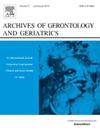1990年至2021年因跌倒导致的椎体骨折的全球、地区和国家负担及未来15年的预测:2021年全球疾病负担研究的系统分析
IF 3.5
3区 医学
Q2 GERIATRICS & GERONTOLOGY
引用次数: 0
摘要
本研究利用2021年全球疾病负担研究的最新数据,分析1990年至2021年椎体骨折致残的发生率、患病率和生存年限,为有效的管理和预防策略提供信息。方法本研究描述了因跌倒导致的椎体骨折的发病率、患病率和残疾生活年数(YLDs)的趋势。采用年龄-时期-队列(Age-Period-Cohort, APC)模型、连接点回归分析和分解分析等方法进行进一步研究,计算出ASIR、ASPR和ASYR。最后,利用自回归综合移动平均(ARIMA)模型预测了未来15年的发病率趋势。结果2021年,全球因跌倒导致的椎体骨折新发病例达470万例,总患病率为367万例,残疾生活年(YLDs)达37万。与1990年相比,估计年变化百分比(EAPC)分别为-0.37(-0.41,-0.32)、-0.35(-0.39,-0.31)和-0.37(-0.41,-0.33),呈下降趋势。不同国家和地区的疾病负担存在显著差异。APC模型、Joinpoint模型和ARIMA预测模型均显示椎体骨折疾病负担呈全球下降趋势。结论椎体骨折的负担虽然呈下降趋势,但在中低SDI地区和老年人群中仍在继续增加。因此,有针对性的预防措施仍然是必要的,以解决与椎体骨折相关的健康结果。本文章由计算机程序翻译,如有差异,请以英文原文为准。
Global, regional, and national burden of vertebral fractures due to falls from 1990 to 2021 and predictions for the next 15 years: A systematic analysis of the global burden of disease 2021 study
Objectives
This study utilized the latest data from the 2021 Global Burden of Disease Study to analyze the incidence, prevalence, and years lived with disability due to vertebral fractures from 1990 to 2021, providing information for effective management and prevention strategies.
Methods
This study describes the trends in incidence, prevalence, and years lived with disability (YLDs) due to vertebral fractures caused by falls. It employs methods such as the Age-Period-Cohort (APC) model, joinpoint regression analysis, and decomposition analysis for further investigation, and calculates the ASIR, ASPR, and ASYR. Finally, it predicts the incidence trend for the next 15 years using the Autoregressive Integrated Moving Average (ARIMA) model.
Results
In 2021, the number of new cases of vertebral fractures due to falls globally reached 4.7 million, with a total prevalence of 3.67 million cases, and years lived with disability (YLDs) amounted to 370,000. Compared to 1990, the estimated annual percentage change (EAPC) was -0.37 (-0.41, -0.32), -0.35 (-0.39, -0.31), and -0.37 (-0.41, -0.33) respectively, indicating a declining trend. There are significant differences in the disease burden among different countries and regions. The APC model, Joinpoint model, and ARIMA forecasting model indicate a global declining trend in the disease burden of vertebral fractures.
Conclusions
Although the burden of vertebral fractures is on a downward trend, it continues to increase in low and middle SDI regions, as well as among the elderly population. Therefore, targeted preventive measures are still necessary to address the health outcomes related to vertebral fractures.
求助全文
通过发布文献求助,成功后即可免费获取论文全文。
去求助
来源期刊
CiteScore
7.30
自引率
5.00%
发文量
198
审稿时长
16 days
期刊介绍:
Archives of Gerontology and Geriatrics provides a medium for the publication of papers from the fields of experimental gerontology and clinical and social geriatrics. The principal aim of the journal is to facilitate the exchange of information between specialists in these three fields of gerontological research. Experimental papers dealing with the basic mechanisms of aging at molecular, cellular, tissue or organ levels will be published.
Clinical papers will be accepted if they provide sufficiently new information or are of fundamental importance for the knowledge of human aging. Purely descriptive clinical papers will be accepted only if the results permit further interpretation. Papers dealing with anti-aging pharmacological preparations in humans are welcome. Papers on the social aspects of geriatrics will be accepted if they are of general interest regarding the epidemiology of aging and the efficiency and working methods of the social organizations for the health care of the elderly.

 求助内容:
求助内容: 应助结果提醒方式:
应助结果提醒方式:


